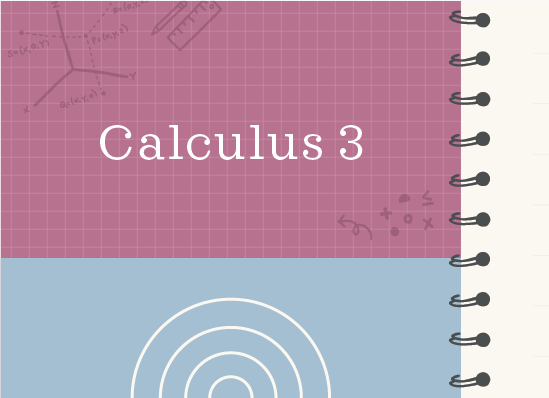How to find the volume of the parallelepiped from its adjacent edges
Formulas for volume of the parallelepiped
If we need to find the volume of a parallelepiped and we’re given three adjacent edges of it, all we have to do is find the scalar triple product of the three vectors that define the edges:
Hi! I'm krista.
I create online courses to help you rock your math class. Read more.
???|\vec{PS}\cdot(\vec{PQ}\times \vec{PR})|???
where ???\vec{PS}???, ???\vec{PQ}??? and ???\vec{PR}??? are the three adjacent edges.
First we’ll find the vectors ???\vec{PQ}???, ???\vec{PR}??? and ???\vec{PS}???, then we’ll find the cross product ???\vec{PQ}\times \vec{PR}??? using the ???3\times 3??? matrix
???\begin{vmatrix}\bold i&\bold j&\bold k\\PQ_1&PQ_2&PQ_3\\PR_1&PR_2&PR_3\end{vmatrix}=\bold i\begin{vmatrix}PQ_2&PQ_3\\PR_2&PR_3\end{vmatrix}-\bold j\begin{vmatrix}PQ_1&PQ_3\\PR_1&PR_3\end{vmatrix}+\bold k\begin{vmatrix}PQ_1&PQ_2\\PR_1&PR_2\end{vmatrix}???
???=(PQ_2PR_3-PQ_3PR_2)\bold i-(PQ_1PR_3-PQ_3PR_1)\bold j+(PQ_1PR_2-PQ_2PR_1)\bold k???
We’ll convert the result of the cross product into standard vector form, and then take the dot product of ???\vec{PS}\langle{PS_1},PS_2,PS_3\rangle??? and the vector result of ???\vec{PQ}\times\vec{PR}???. The final answer is the value of the scalar triple product, which is the volume of the parallelepiped.
How to find the volume of a parallelepiped, given three vectors that define its edges
Take the course
Want to learn more about Calculus 3? I have a step-by-step course for that. :)
Building three vectors from four points, then using the vectors to find the parallelepiped’s volume
Example
Find the volume of the parallelepiped given by the adjacent edges ???\vec{PQ}???, ???\vec{PR}??? and ???\vec{PS}???.
???P(5,1,-2)???
???Q(0,-1,3)???
???R(3,2,-4)???
???S(1,-2,0)???
We need to start by using the four points to find the vectors ???\vec{PQ}???, ???\vec{PR}??? and ???\vec{PS}???, since these are the three adjacent edges of the parallelepiped.
???\vec{PQ}=\langle0-5,-1-1,3-(-2)\rangle???
???\vec{PQ}=\langle-5,-2,5\rangle???
and
???\vec{PR}=\langle3-5,2-1,-4-(-2)\rangle???
???\vec{PR}=\langle-2,1,-2\rangle???
and
???\vec{PS}=\langle1-5,-2-1,0-(-2)\rangle???
???\vec{PS}=\langle-4,-3,2\rangle???
The final answer is the value of the scalar triple product, which is the volume of the parallelepiped.
Now we need to take the cross product of ???\vec{PQ}??? and ???\vec{PR}???.
???\vec{PQ}\times\vec{PR}=\begin{vmatrix}\bold i&\bold j&\bold k\\-5&-2&5\\-2&1&-2\end{vmatrix}???
???\vec{PQ}\times\vec{PR}=\bold i\begin{vmatrix}-2&5\\1&-2\end{vmatrix}-\bold j\begin{vmatrix}-5&5\\-2&-2\end{vmatrix}+\bold k\begin{vmatrix}-5&-2\\-2&1\end{vmatrix}???
???\vec{PQ}\times\vec{PR}=\left[(-2)(-2)-(5)(1)\right]\bold i-\left[(-5)(-2)-(5)(-2)\right]\bold j+\left[(-5)(1)-(-2)(-2)\right]\bold k???
???\vec{PQ}\times\vec{PR}=(4-5)\bold i-(10+10)\bold j+(-5-4)\bold k???
???\vec{PQ}\times\vec{PR}=-\bold i-20\bold j-9\bold k???
???\vec{PQ}\times\vec{PR}=\langle-1,-20,-9\rangle???
Taking the dot product of ???\vec{PS}=\langle-4,-3,2\rangle??? and ???\vec{PQ}\times\vec{PR}=\langle-1,-20,-9\rangle???, we get
???\left|\vec{PS}\cdot\left(\vec{PQ}\times\vec{PR}\right)\right|=(-4)(-1)+(-3)(-20)+(2)(-9)???
???\left|\vec{PS}\cdot\left(\vec{PQ}\times\vec{PR}\right)\right|=4+60-18???
???\left|\vec{PS}\cdot\left(\vec{PQ}\times\vec{PR}\right)\right|=46???
The volume of the parallelepiped is ???46???.






